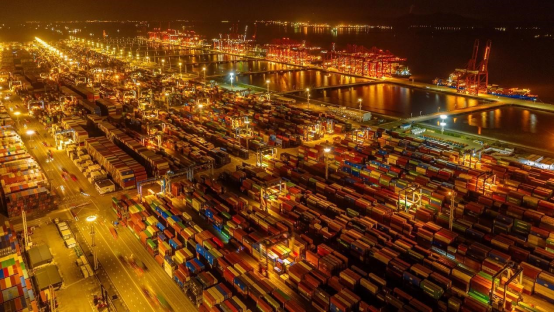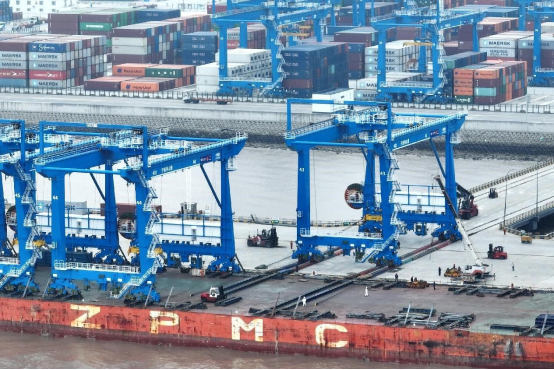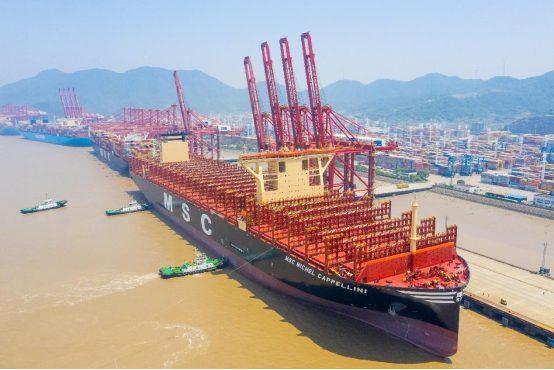E China's Ningbo-Zhoushan Port strives to become world-class port
2023.08.17
Ningbo-Zhoushan Port in east China's Zhejiang province, the world's first port to achieve an annual cargo throughput of over one billion tonnes, contributes significantly to the stable operation of China's foreign trade industrial and supply chains as well as the high-quality development of the Chinese economy.

Photo shows a view of the brightly lit container terminal of the Meishan port area of Ningbo-Zhoushan Port in east China's Zhejiang province. (People's Daily Online/Pan Weifeng)
During the first half of this year, the port saw its cargo throughput climb 6 percent year-on-year to 679 million tonnes, while its container throughput rise 1.2 percent, compared to the same period last year, to 17.68 million 20-foot equivalent units (TEUs), according to data released by the port, on July 7, 2023.
Burgeoning ports promise booming trade. Ports are considered a barometer of a country's foreign trade and national economic development. In recent years, cities across China have leveraged smart manufacturing to boost efficient operation of ports, empowered the construction of smart ports with digital technologies, and facilitated green development of ports with sci-tech innovations.
Thanks to these efforts, the country's key shipping routes have enjoyed unimpeded, efficient, stable, and orderly operations, playing a positive role in guaranteeing the stability of industrial and supply chains. By helping better unleash the potential of the Chinese economy, these ports inject new impetus into global economic growth.
Ningbo-Zhoushan Port enjoys favorable geographical location and superior natural conditions. It lies at the meeting point of the Silk Road Economic Belt and the 21st Century Maritime Silk Road, backed by the Yangtze River Delta economic circle, and facing the main maritime shipping routes on the Pacific Ocean.
The port is one of the few deep-water ports in the world. The main channels of its core port area are over 22.5 meters deep, allowing 300,000-tonnage vessels to freely enter and depart the port, while 400,000-tonnage vessels can enter and depart the port during high tides.

Automated track cranes are being installed at the container terminal of the Jintang port area of Ningbo-Zhoushan Port in east China's Zhejiang province, April 21, 2023. (People's Daily Online/Yao Feng)
The port also boasts first-class infrastructure. It has over 200 berths for 10,000-tonne vessels and above and more than 120 large and extra-large deep-water berths for 50,000-tonne vessels and above, making it the port with the most large and extra-large deep-water berths in the Chinese mainland.
Because of its unparalleled strengths, Ningbo-Zhoushan Port has ranked first in the world in annual cargo throughput for 14 consecutive years. Last year, it handled 33.35 million TEUs of containers, maintaining its position as the world's third largest port in terms of container throughput.
The port is also the second largest port in China in terms of sea-rail intermodal cargo transportation volume. It operates 23 sea-rail intermodal train routes, providing services covering 63 prefecture-level cities in 16 provinces across the country.
The port has opened 122 shipping routes connecting China and countries and regions along the Belt and Road, and has increased its number of maritime shipping routes to Central and Eastern Europe to 14. Last year, the port and five ports in Central and Eastern Europe handled 769,000 TEUs of containers for foreign trade between China and Central and Eastern Europe, up 16.5 percent compared to the previous year.
On July 5, 2023, 400,000-tonne ore carrier Ore Brasil docked slowly at the No. 1 berth of the Shulanghu ore transfer terminal of the Ningbo-Zhoushan Port with the help of several tugboats. With this, all 68 ore carriers with the largest capacity of 400,000 tonnes in the world had sailed to the Ningbo-Zhoushan Port, fully demonstrating the port's advantage of being a comprehensive hub port.

Ultra-large container ship MSC Michel Cappellini sails slowly into a berth with the help of tugboats at the container terminal of the Chuanshan port area of Ningbo-Zhoushan Port in east China's Zhejiang province, June 2, 2023. (People's Daily Online/Jiang Xiaodong)
At present, Ningbo-Zhoushan Port is striving to usher in a new phase of growth by advancing smart port construction and promoting green and low-carbon transformation.
The terminal in the Meishan port area of Ningbo-Zhoushan Port has significantly improved operational efficiency through intelligent facilities, such as unmanned container trucks and remotely controlled automated gantry cranes and bridge cranes.
In an effort to enhance energy conservation and cut carbon emissions, the terminal has adopted photovoltaic technology to provide solar power for some of its equipment. Meanwhile, it has achieved 100-percent shore-side power coverage, providing clean energy to ships berthed at the port area.
The busy and thriving scenes and streams of substantive data from the Ningbo-Zhoushan Port inspire confidence and hearten people.
With over 300 container shipping routes linking more than 600 ports in over 200 countries and regions, the port has woven a maritime shipping and trade network that connects China to the rest of the world, contributing to China's efforts to foster a new pattern of development that is focused on the domestic economy and features positive interplay between domestic and international economic flows.



